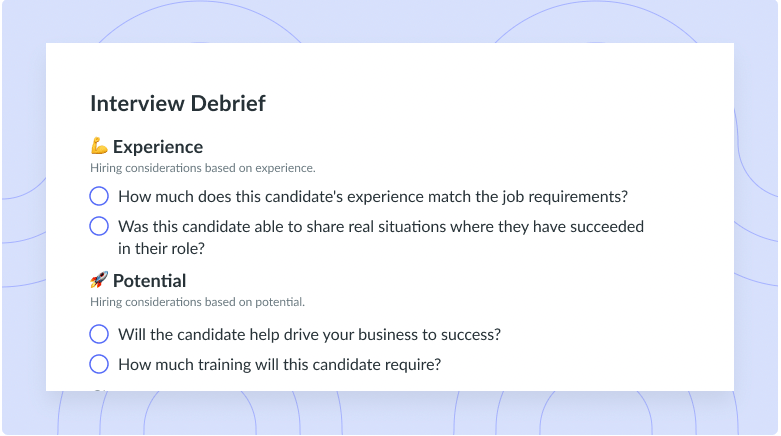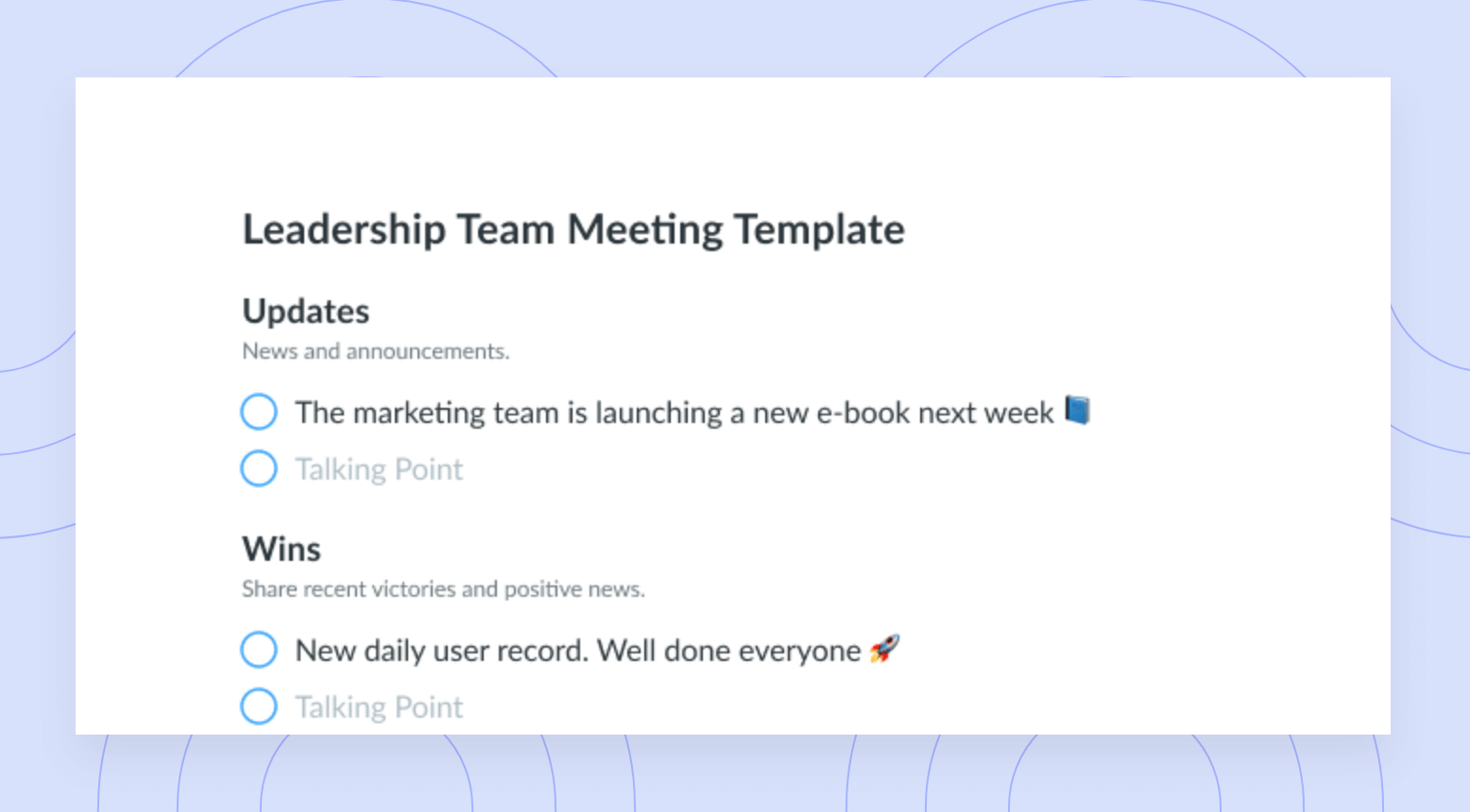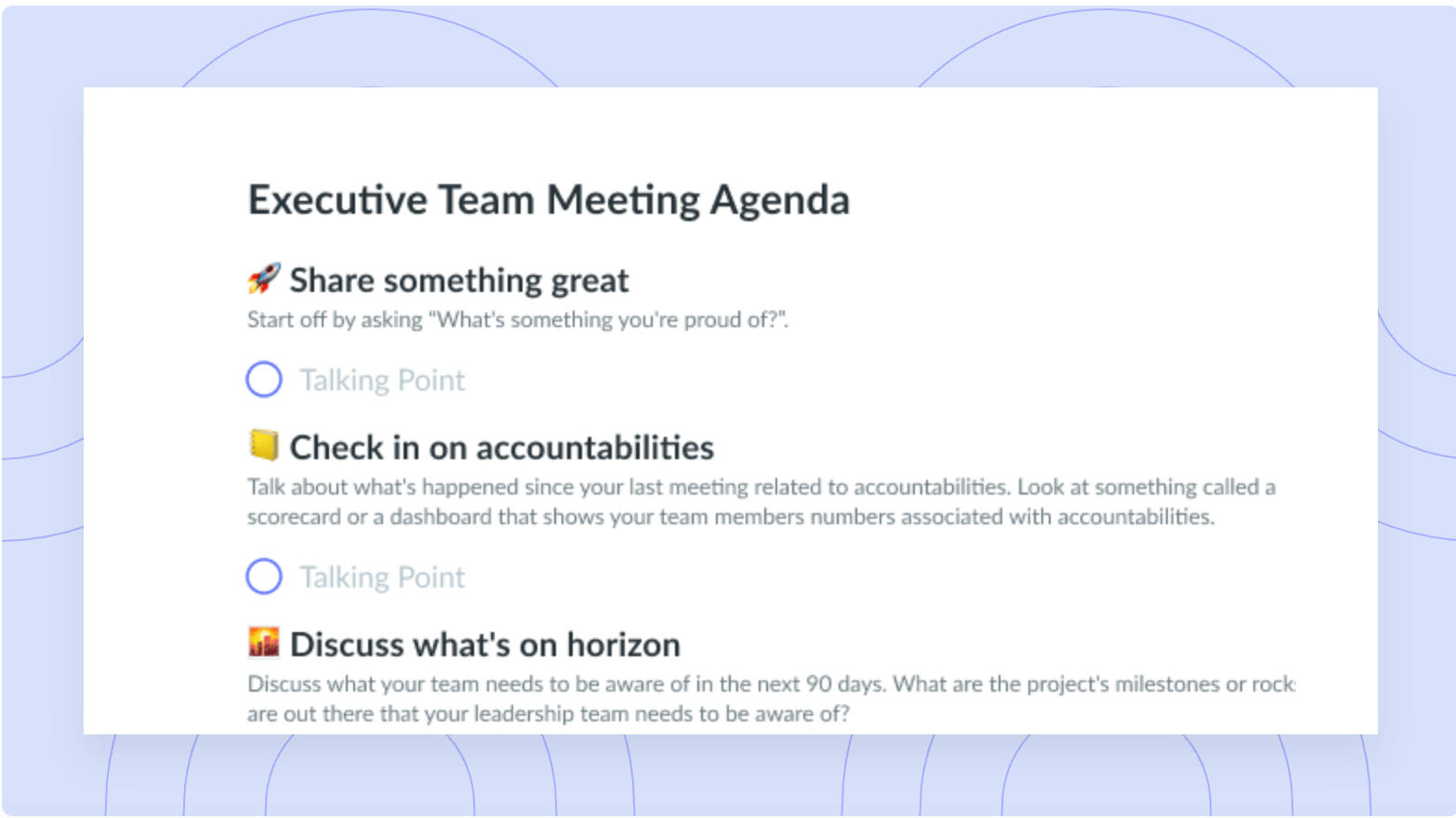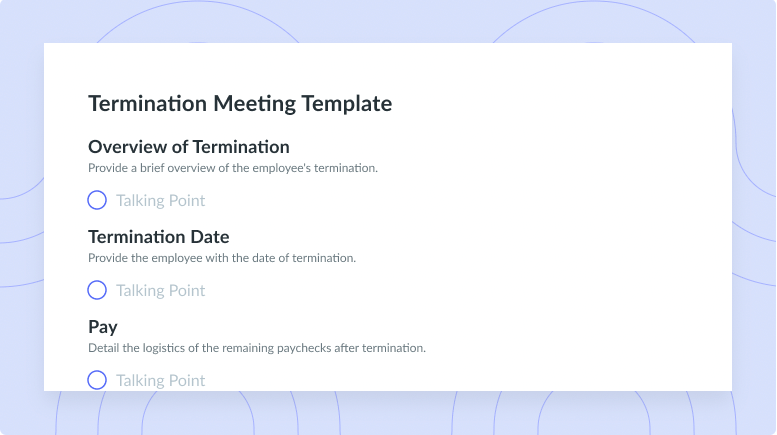Decision-Making Meeting: Here’s How to Efficiently Run It
Decision-making meetings are key to making the tough calls that can drive your organization forward. Learn how to host these meetings here.
Sometimes, you’ll have to make decisions that you can’t quite reach alone. Decision-making meetings are a great solution. They gather managers, leaders, and sometimes team members to finalize difficult decisions. Read on to learn how to run an effective decision-making meeting and find a few examples of when to host one.
- What is a decision-making meeting?
- How to run a decision-making meeting
- Who attends a decision-making meeting?
- Examples of decision-making meetings
- Free decision-making meeting agenda templates
What is a decision-making meeting?
A decision-making meeting is a gathering of leaders and managers (and, sometimes, other team members) to make a call on important business decisions. These decisions typically take time, so they require more than the usual quick moment of thought during your weekly recap meeting. Decision-making meetings give you that time.
There are multiple decision-making processes your team can go through in your meeting to find a solution. Some ways to make a decision include gathering and sharing information, brainstorming, weighing out pros and cons, and problem-solving. The goal is unanimous agreement about a decision, and once your team gets there, you’ll need to create a plan to act on it.

Run delightful decision-making meetings
Increase meeting engagement and productivity with a collaborative agenda that the whole team can contribute to. Try using a tool like Fellow!

How to run a decision-making meeting
An effective decision-making meeting starts with a thorough meeting agenda. You should send your agenda to everyone before the meeting so they have time to prepare notes and ideas. If you need some inspiration, here’s how you can lay out your agenda to run a great decision-making meeting.
- State the goal
- Share the decision to be made
- Go over your options
- Decide and commit
- Take your next steps
1State the goal
One of the most effective ways to have a great decision-making meeting is to always keep your end goal in mind. Why did you call this meeting in the first place? What problem are you trying to solve? Once you clearly understand the purpose and goal of your meeting, you’ll be more inclined to reach it.
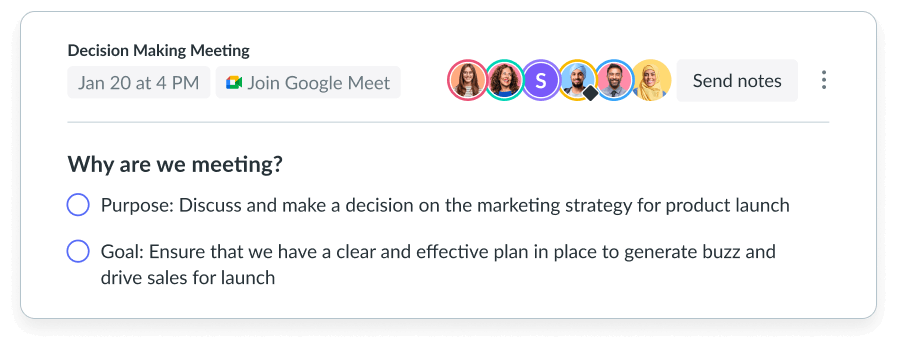
2Share the decision to be made
After defining your goal, you now need to fine-tune the details. For example, if your goal is choosing a new hire, then who are the candidates? Or maybe you need to determine who should be on the cover for your upcoming publication.
At the beginning of the meeting, you should remind everyone what decision needs to be made so everyone starts on the same page. That’s how everyone ends there too.
3Go over your options
Not every decision-making meeting will have everyone on board within the first 15 minutes – in fact, most won’t. These meetings can take a while because you need to weigh out all your options to find the best one.
You can save some time if you ask everyone to come prepared with ideas on what they believe is the best course of action. Then, once the meeting begins, go around so everyone can share their thoughts . Once you’ve heard everyone’s idea, you can open up the floor for a debate. With Fellow, you can run productive meetings by using collaborative meeting agendas.
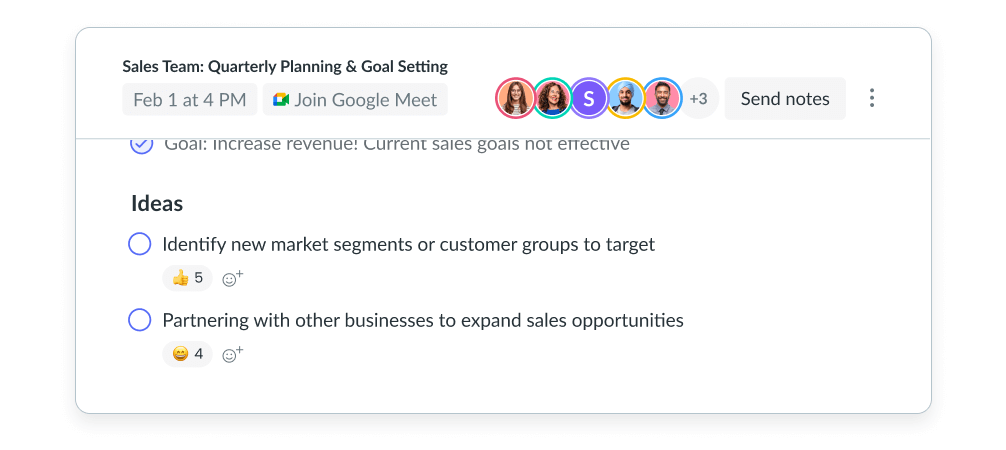
4Decide and commit
Sometimes, after hearing each team member’s perspective, you might easily reach a decision. But if not everyone is in agreement, you may need to hold a vote to reach a final decision. First, see if you can narrow things down to two options. Then, ask each team member to write their final decision on a piece of paper. Count it all up, and whichever choice has the most votes is the final decision.
5Take your next steps
Now that you’ve reached a decision, it’s time to take your next steps. For example, if you’ve chosen who you want to hire, you’ll need to go through the onboarding process. Your next steps will depend on the decision you’ve made, but no matter what, you should always assign meeting action items afterward. This way, you actually make good on your decision.

Who attends a decision-making meeting?
When making important decisions, you don’t want to invite too many people to your meeting. Too many ideas and thoughts could make the conversation run long and delay a decision. Below are some pointers about who should get your meeting invitations come decision time.
Meeting facilitator
Ideally, you want to have someone in charge of your decision-making meeting. This meeting facilitator can guide the conversation behind your final decision. Your facilitator is also responsible for keeping your meeting from going overtime or veering off-topic.
People with decision-making authority
Decision-making meetings should lead to action, which means most of the people there should have the authority to act as decision-makers. These people can have a significant say in what the final decision should be. And ideally, one of these people should be your meeting facilitator. This way, the same person who directs the meeting can transform the conversation into a sound decision.
Notetaker and process observer
Any meeting, whether a decision-making meeting or a weekly status update, can get off-topic fast without guardrails in place. To make sure you have an effective meeting, you should include two team members who aren’t involved in the decision-making process. These people can be your note taker and process observer. You can choose anyone you trust to not weigh in on the decisions being made or share any details with people who weren’t there.
The notetaker will record meeting notes that go over what everyone brainstormed and what decisions were made. The process observer will write down how the final decision was met and jump in if things get off-track. These two roles can save time during your meeting and future ones, so they’re a must-have for any great decision-making meeting. So too is a great meeting software platform.
Examples of decision-making meetings
Below are a few examples of why you might need to host a decision-making meeting.
New hire
Often, a hiring manager will see a few exceptional candidates who can fill the role of one position. That, of course, can make it difficult to choose one person for the job. And that, in turn, might mean it’s time to call in some backup – as in, more team members to help decide.
In a new hire decision-making meeting, a hiring manager could bring in team members in their department. These team members will work with the new hire, so their input matters (but keep it professional!). The new hire’s manager-to-be should be there too so they can raise any potential concerns.
Go/no-go decision
A go/no-go decision determines whether or not you move forward with a project. It requires managers, leaders, and team members to brainstorm and decide whether a project is a good fit. It typically involves a formal checklist or table that helps you figure out whether you can jump right in, change some things and then start, or say no entirely. The checklist might change depending on the project, but it’s always necessary in the decision-making process.
Logo selection
Logos are how people remember your organization. People will see it on your business cards, office, storefronts, products, website, and social media. That can make choosing a logo one of the most difficult decisions you’ll have to make. That’s why it’s a choice better made as a team.
Prior to your decision-making meeting, you may want to ask everyone to brainstorm color options, font styles and sketch out a few designs. This could help you see how your team thinks of your business and find any overlaps in color options or designs.
Final approval of a publication
Before sending anything written out into the public, you’ll need all hands on deck to make sure it’s error-free and ideologically sound. So grab your team of editors, department leads, and managers together for a final run-through during a decision-making meeting.
With everyone included, you’ll have more eyes searching through every detail, and it’ll be easier to catch any mistakes you might have missed. This way, you can decide when the publication is ready to go.
Quarterly goals
A quarterly goal meeting can go further than just including managers and meeting leaders. You also want to meet with each team member to discuss their personal goals. And sure, you’ll need to set goals for your organization too, but successful team members make for a successful organization. Whether you’re going over quarterly goals with team members or leadership, SMART goals are your best bet for making your biggest ambitions happen.
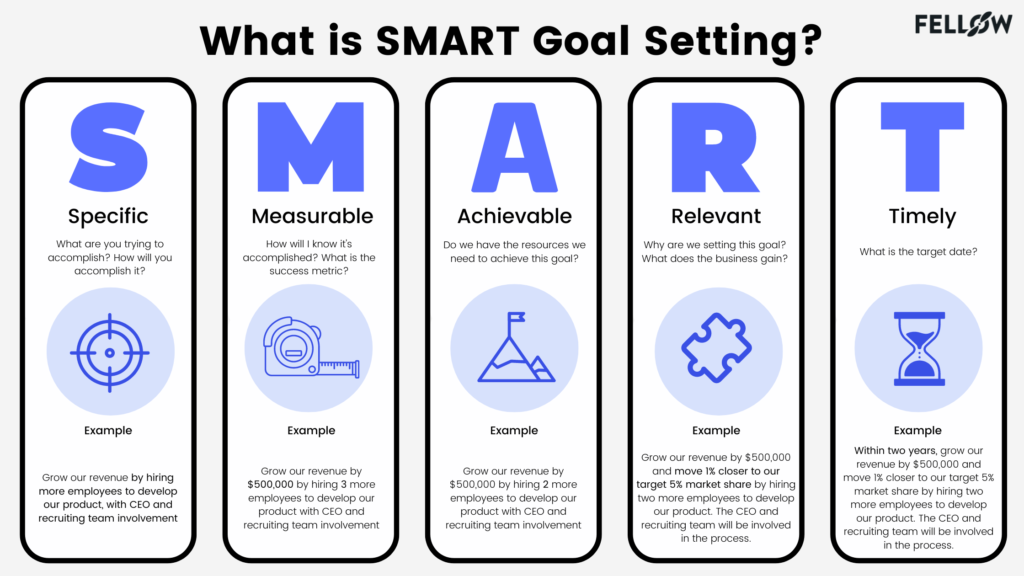
Budget
You should set budgets monthly or quarterly with your whole leadership and management teams present. The decision-making approach at these meetings will involve going over what you spent last period versus what you had planned. You can use that information to switch things up this period and build a more realistic budget. This is also a good time to ask department leads why they went over budget or how they stayed under.
Free decision-making meeting agenda templates
Decision-Making Meeting Template
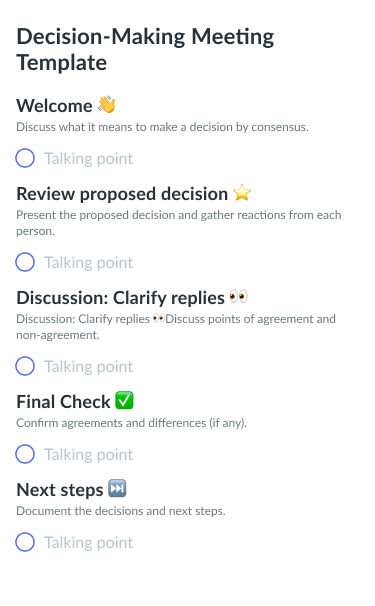
B.R.A.I.N Decision-Making Meeting Template
B.R.A.I.N stands for Benefits, Risks, and Alternatives to a decision.
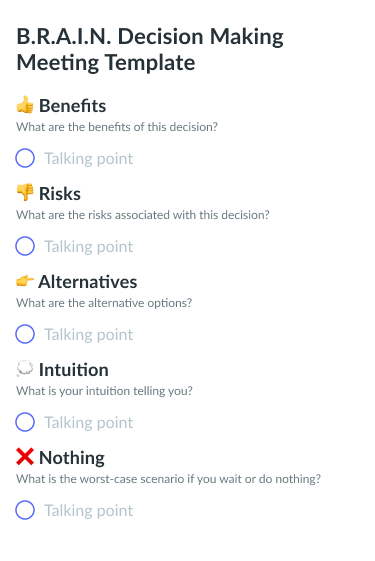
Leadership Decision-Making Meeting Template
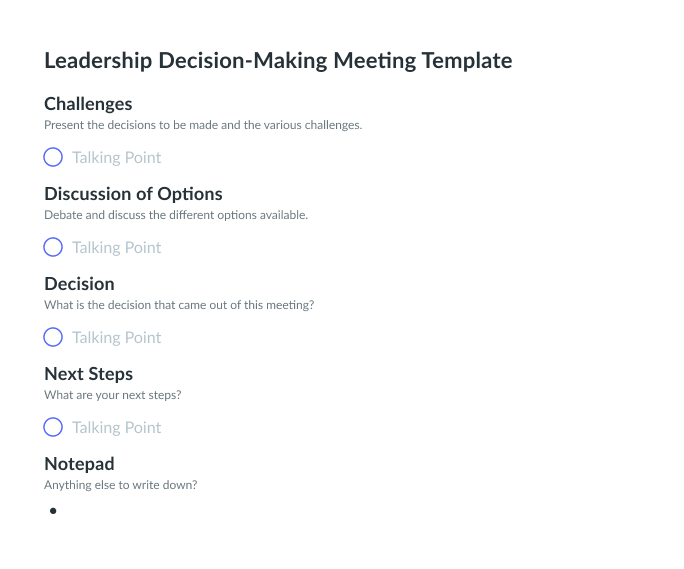
Prepare for your decision-making meeting with Fellow
Taking the time to meet with managers, leaders, and certain team members can help you make good decisions. Preparing for your decision-making meetings gets easier if you can collaboratively create meeting agendas and gather feedback from the same platform. With Fellow, you can do both while assigning action items to each of your team members so you can follow through on your decision. Making decisions as a group – and acting on them – has never been this easy.




![How to Successfully Run a Team Update Meeting [+ Examples]](https://fellow.app/wp-content/uploads/2022/06/How-to-Run-a-Team-Updates.jpg)
![Status Meeting: 9 Best Practices For an Effective Meeting [+ Free Templates]](https://fellow.app/wp-content/uploads/2022/05/Status-Meetings-2.jpg)
![A Guide to Taking Good Interview Notes [+Free Templates]](https://fellow.app/wp-content/uploads/2023/09/interview-notes.jpg)


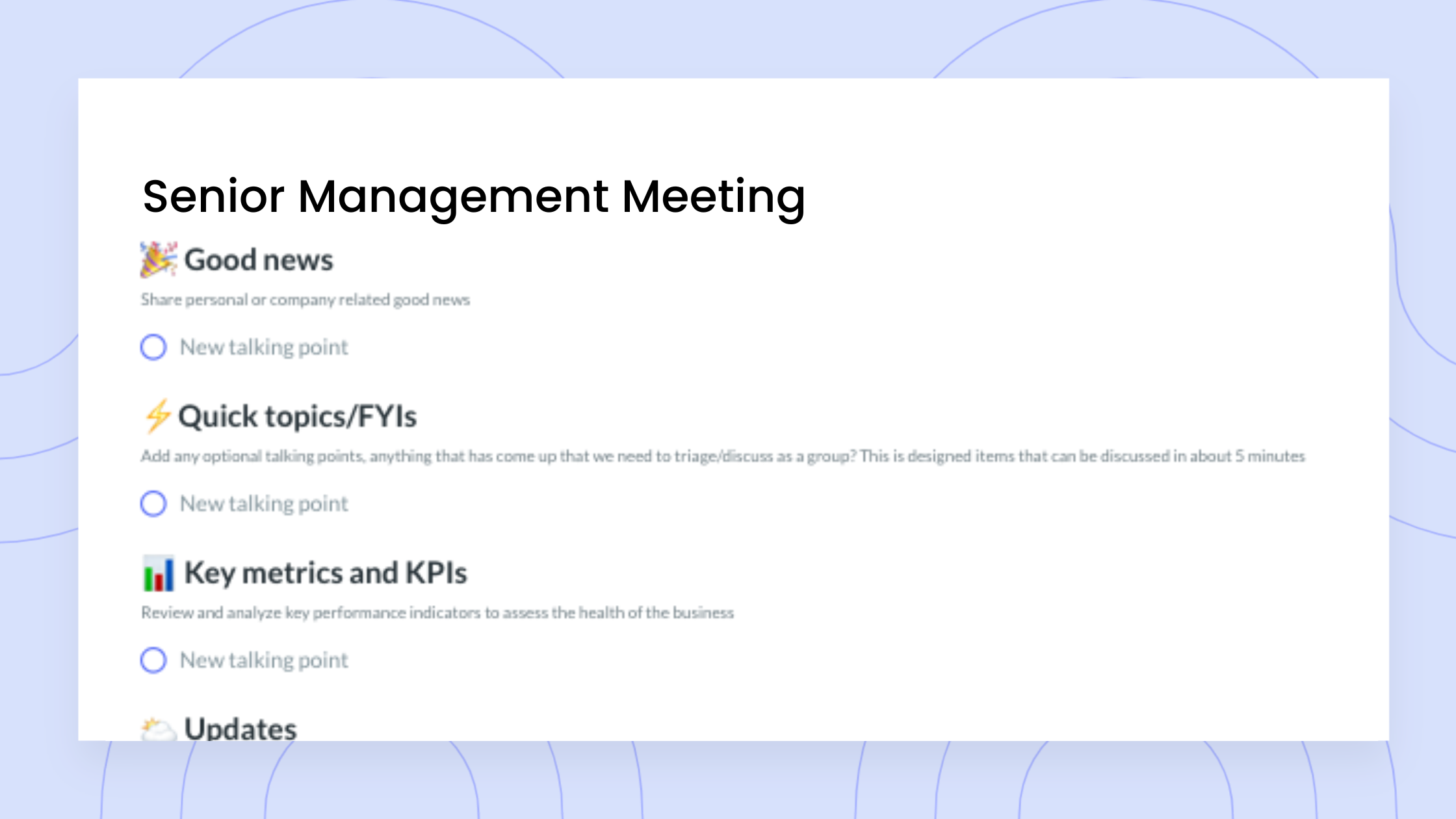
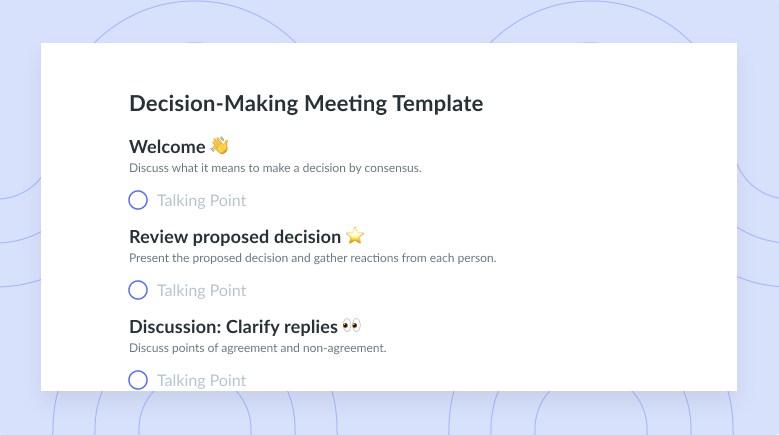
![Incoming Client Interview [Legal Clinic] Template](https://fellow.app/wp-content/uploads/2021/09/Incoming-Client-Interview-Legal-Clinic-preview.png)
